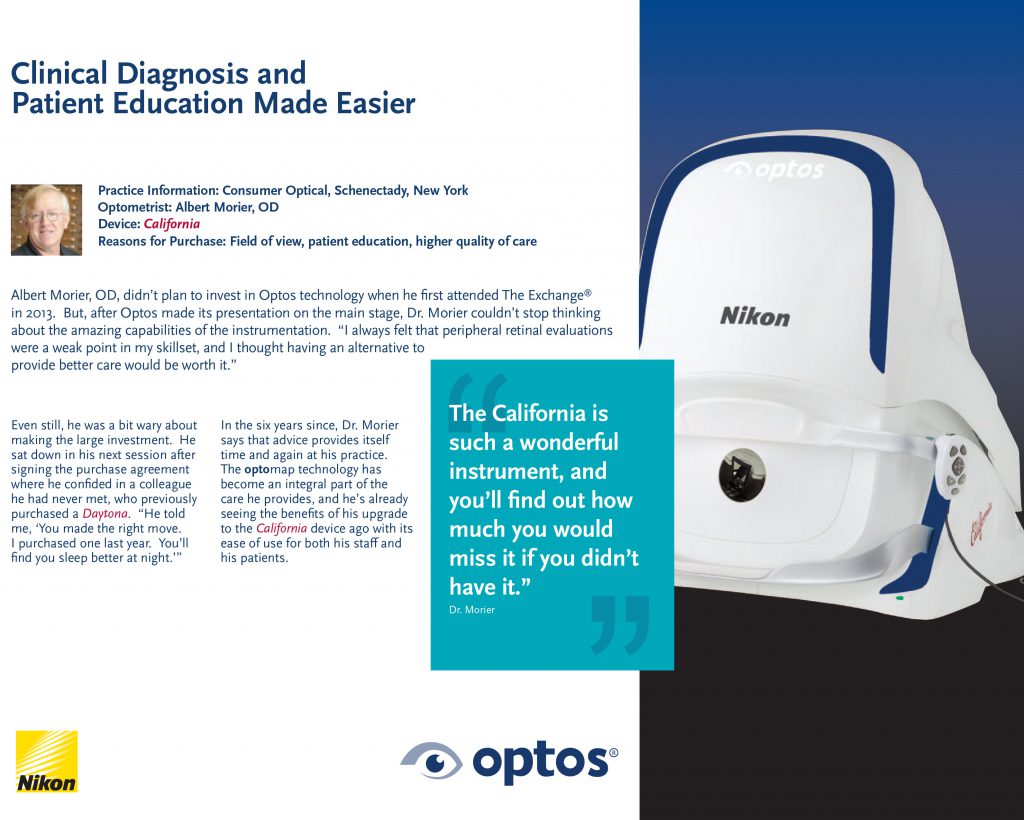Albert Morier, OD, didn’t plan to invest in Optos technology when he first attended The Exchange® at Vision Source in 2013. But, after the company made its presentation on the main stage, Dr. Morier couldn’t stop thinking about the amazing capabilities of the instrumentation. Even still, he was a bit wary after making the investment. He sat down in his next session after signing the purchase agreement where he confided in a colleague he had never met, who previously purchased a Daytona. “He told me, ‘You made the right move. I purchased one last year. You’ll find you sleep better at night.’” In the six years since, Dr. Morier says that advice proves itself time and again at his practice, Consumer Optical in Schenectady, New York. The optomap® technology has become an integral part of the care he provides, and he’s already seeing the benefits of his upgrade to the California device three months ago with its ease of use for both his staff and his patients.
There are several patient experiences with optomap technology that stand out to Dr. Morier. First, is a patient who he saw at another office. He was unable to dilate the patient with two sets of drops, so he referred him to Consumer Optical for optomap imaging. The patient told Dr. Morier that an ophthalmologist had been monitoring a freckle on his eye every year. When he saw the patient’s images, they revealed it was not a nevus, but a melanoma. The image also showed diabetic retinopathy adjacent to the optic nerve. The patient was referred to an ophthalmologist at Mass Eye and Ear, who confirmed the diagnosis. Because Dr. Morier was able to show the patient the areas of concern, the patient was persistent in getting answers and following through with other specialists.
In a second case, a patient opted to discuss the optomap screening with Dr.Morier, and after he agreed, Dr.Morier saw clear signs of a horseshoe tear and detached retina. The patient had experienced minor symptoms of a flash of light a month before, but nothing since then, he was incredibly impressed with Dr. Morier’s findings.
Dr. Morier stresses the technology and education it provides is impressive, even if the findings are routine. As he details the parts of the eye, from the optic nerve to the macula and nerve fibers, patients are wowed. He explains that this information is a baseline to compare for years to come that will allow him to pick up on even the smallest changes. He also offers to provide patients who are moving away from the area with their optomap images on a USB drive in order for their new doctor to have the baseline data as well.
Dr. Morier appreciates the support he’s received from his Optos representative. “He’s sincere, and he was very instrumental as we made the adjustment to our California,” he says. Dr. Morier encourages his colleagues to take the leap. “The price tag may worry you, but with routine screening as part of a comprehensive eye exam as well as and diabetic screenings, you will come out in the plus column no matter what.” The return on investment is multifaceted, with a hard return on the financial investment but also a soft return gain with the valuable impressions the technology will make on patients.
While we begin to adapt to new norms, eye care remains a top priority, and it’s important to continue to provide patients the technological advancements available with optomap. optomap provides the technology to make clinical diagnosis and patient education easier. Visit our website to learn additional benefits of implementing optomap in your clinical setting and provide the highest level of care to your patients.

